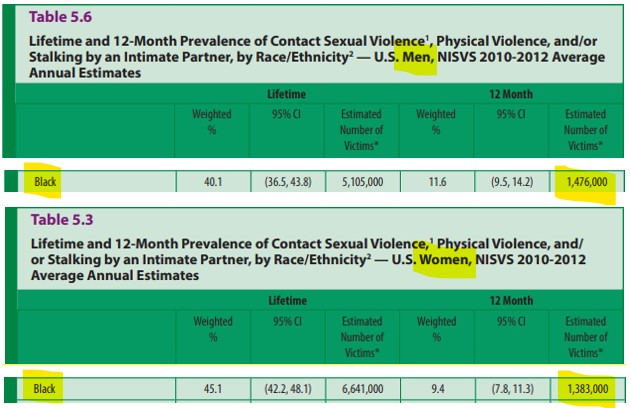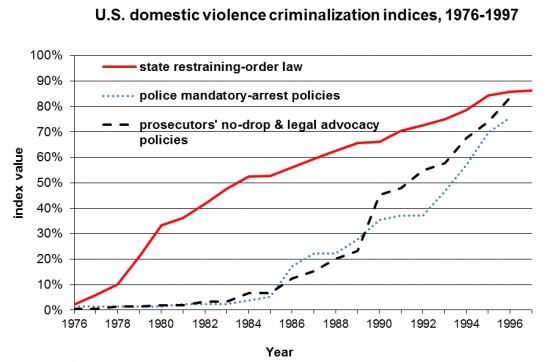African-Americans Call on Lawmakers to Reform ‘Broken’ Domestic Violence Policies
It is widely recognized that our domestic violence system is broken. The courts are overrun with minor cases, creating a situation where severe cases are hard to detect. Mandatory arrest policies are likely to increase future homicides. And bias against African-American men is rampant.
- Sign the petition: Help Stop the Mass Arrest of Black Men!
1. Curb False Allegations
Eight percent of Americans report they have been falsely accused of domestic violence, child abuse, or sexual assault. Four states have passed legislation designed to end false 911 reports that are made to harass a person based on sex, race, or sexual orientation: New York, California, Connecticut, and New Jersey.
2. End Mandatory Arrest
Many states have policies that mandate or encourage arrest for domestic violence. Such policies likely violate constitutional “probable cause” requirements and are biased against males. In most cases, victims do not want the offender to be arrested; they only want the abuse to stop.
3. Eliminate Predominant Aggressor Policies
In many cases, intimate partner violence is mutual, meaning both persons are exchanging blows. Police officers are discouraged from arresting both persons, so they decide who to arrest based on sex-biased “predominant aggressor” policies that include questions about “height” and “weight.” No surprise, in 4 out of 5 cases, it’s the male who is arrested.
4. End ‘No-Drop’ Prosecution Policies
For most crimes, the prosecutor has discretion whether or not to pursue the case, depending on the strength of the evidence. But with No-Drop policies, the prosecutor is forced to pursue the case, even when the victim is not cooperative.
5. Expand the Availability of Diversion Programs
When serious physical abuse occurs, domestic violence diversion programs provide the offender with critical anger management, substance abuse, and mental health services. Such diversion programs should be made more widely available.
More information is available here: www.endtodv.org/solutions
+++++++++++++++++++++++++++++++++
Eight Facts Why DV Policies are Harmful to Black Men
Each Year 10,000 Black Men are Unjustly Handed a Criminal Record and Labelled as ‘Abusers.’
Even though Black men usually are the victims of partner abuse.
Fact #1: Current domestic violence policies do not respect victims’ wishes:
- The current system does not respect the needs or wishes of victims. In most cases, the victim wants the abuse to stop, but does not want the offender to be arrested.
- As a result, victims have stopped calling the police for help:
- “Victims don’t want to call the police after the [mandatory arrest] laws were implemented.” — Radha Iyengar, PhD1
Fact #2: The over-incarceration of Black men is a serious threat to justice in our nation:2
- According to the Bureau of Justice Statistics, “black males were imprisoned at rates that ranged between 5 and 7 times the rates of white males.”3
- An arrest gives the man a criminal record, even if he is later cleared of all charges.
- A criminal record has long-term, harmful effects on career prospects, family relationships, and future involvement with the criminal system.
Fact #3: Each year, 1.47 million Black men, compared to 1.38 million Black women, are victims of sexual violence, domestic violence, or stalking:4

- Videos:
Fact #4: Even though the majority of partner abuse victims are male (see table, above), 81% of intimate partner violence arrestees are male:5
- This means there is more than a four-fold difference in the number of male vs. female African-Americans arrested for domestic violence each year:6
- Males: 27,031
- Females: 6,341
- About three-fifths of these arrests result in the filing of charges and subsequent prosecution.7
Fact #5: Each year, 10,879 Black men are wrongfully arrested for partner abuse8
- Observers have referred to this violation of civil rights as “mass incarceration:”
- The “criminalization of social problems has led to mass incarceration of men, especially young men of color” – Ms. Foundation for Women9
- “Day after day, prosecutors proceeded with cases against the wishes of victims, resulting in the mass incarceration of young Black men.” — Law Professor Aya Gruber10
Fact #6: Domestic violence laws are a major cause of the over-incarceration of Black men:11
- All states have enacted restraining order laws, of which 33 states mandate arrest for violation of a restraining order12 – see red line, below
- 22 jurisdictions have implemented mandatory arrest laws for allegations of domestic violence13 – see dotted blue line, below
- Many prosecutors have adopted “no-drop” policies that remove prosecutorial discretion14 – see spaced black line, below
- Many jurisdictions have implemented so-called “predominant aggressor” policies that stereotype men as abusers.15

Fact #7: Despite billions of dollars spent, there is no evidence that these polices have been effective in reducing domestic violence:
- The Office on Violence Against Women has awarded about $10 billion in grants to stop domestic violence, sexual assault, dating violence, and stalking.16 But there is no evidence of effectiveness:17
- “We have no evidence to date that VAWA has led to a decrease in the overall levels of violence against women.” — Angela Moore Parmley, Office of Justice Programs, U.S. Department of Justice
- “Between 2000 and 2010, rates of domestic violence actually fell less than the drop in the overall crime rate – at a time when VAWA was pumping hundreds of millions of dollars into the criminal system.” — Leigh Goodmark, Professor, University of Maryland Law School
Fact #8: Americans want domestic violence programs to be more focused on the provision of mental health services, and less focused on arrest, prosecution, and incarceration:
- A majority of Americans believe domestic violence laws “should create a system in which mental health services are used first, and criminal justice approaches reserved for the more severe or repeated cases of domestic violence”18
- Sen. Patrick Leahy has emphasized, “One size doesn’t fit all in the criminal justice system….I think utilizing restorative justice approaches is one of those necessary improvements” to the Violence Against Women Act.19
- Forty-six state domestic violence/sexual assault coalitions have expressed regret for their over-emphasis on “increased policing, prosecution, and imprisonment as the primary solution” to domestic violence, and instead called for “transformative justice approaches”:20
- Alabama Coalition Against Rape; Alaska Network on Domestic Violence and Sexual Assault; Arkansas Coalition Against Sexual Assault; California Coalition Against Sexual Assault; California Partnership to End Domestic Violence; CAWS North Dakota; Colorado Coalition Against Sexual Assault; End Domestic Abuse Wisconsin; Florida Council Against Sexual Violence; Georgia Coalition Against Domestic Violence; Georgia Network to End Sexual Assault; Idaho Coalition Against Sexual & Domestic Violence; Illinois Coalition Against Domestic Violence; Indiana Coalition Against Domestic Violence; Iowa Coalition Against Domestic Violence; Iowa Coalition Against Sexual Assault; Jane Doe Inc. (Massachusetts Coalition Against Sexual and Domestic Violence); Kentucky Association of Sexual Assault Programs, Inc.; Kentucky Coalition Against Domestic Violence; Maine Coalition Against Sexual Assault; Maine Coalition to End Domestic Violence; Maryland Network Against Domestic Violence; Mississippi Coalition Against Sexual Assault; Montana Coalition Against Domestic and Sexual Violence; Nebraska Coalition to End Sexual and Domestic Violence; Nevada Coalition to End Domestic and Sexual Violence; New Jersey Coalition Against Sexual Assault; New Jersey Coalition to End Domestic Violence; New Mexico Coalition of Sexual Assault Programs, Inc.; New York State Coalition Against Domestic Violence; New York State Coalition Against Sexual Assault; North Carolina Coalition Against Domestic Violence; North Carolina Coalition Against Sexual Assault; Ohio Alliance to End Sexual Violence; Ohio Domestic Violence Network; Pennsylvania Coalition Against Domestic Violence; Pennsylvania Coalition Against Rape; Tennessee Coalition to End Domestic and Sexual Violence; Utah Coalition Against Sexual Assault; Vermont Network Against Domestic and Sexual Violence; Violence Free Colorado; Virginia Sexual & Domestic Violence Action Alliance; Washington Coalition of Sexual Assault Programs; Washington State Coalition Against Domestic Violence; West Virginia Coalition Against Domestic Violence; and the Wisconsin Coalition Against Sexual Assault.
References
1 Radha Iyengar (2007). Does the Certainty of Arrest Reduce Domestic Violence? https://www.nber.org/papers/w13186
2 Robert Brame, Shawn D. Bushway, Ray Paternoster, and Michael G. Turner (2014). Demographic Patterns of Cumulative Arrest Prevalence By Ages 18 and 23. Crime and Delinquency. https://www.ncbi.nlm.nih.gov/pmc/articles/PMC4443707/
3 U.S. Bureau of Justice Statistics (2012), Prisoners in 2011. https://bjs.ojp.gov/content/pub/pdf/p11.pdf
4 Centers for Disease Control, National Intimate Partner and Sexual Violence Survey: 2010-2012 State Report. Tables 5.3 and 5.6. https://www.cdc.gov/violenceprevention/pdf/nisvs-statereportbook.pdf
5 Matthew R. Durose et al (2005), Family Violence Statistics. U.S. Department of Justice, Family violence committed by a spouse or boyfriend/girlfriend. https://bjs.ojp.gov/content/pub/pdf/fvs.pdf ,Table 5.9.
6 Calculation:
- Total number of arrests for intimate partner violence (IPV) by spouse, boyfriend, or girlfriend, all races: 106,962 (Source: https://bjs.ojp.gov/content/pub/pdf/fvs.pdf, Table 5.9)
- Percentage of arrests of Blacks for “Other Assaults:” 31.2% (Source: https://ucr.fbi.gov/crime-in-the-u.s/2019/crime-in-the-u.s.-2019/topic-pages/tables/table-43)
- Sex-specific percentages: (Source: https://bjs.ojp.gov/content/pub/pdf/fvs.pdf, Table 5.9)
- Male: 81%
- Female: 19%
- Calculation for number of Black men arrested each year for domestic violence: 106,962 x .312 x .81 = 27,031
7 Maxwell CD (2009). Prosecution and conviction rates for intimate partner violence. Criminal Justice Review, Vol. 34, No. 1.
8 Calculation:
- Number of partner abuse incidents each year (from table, above):
- Male victims: 1,476,000 (51.6%)
- Female victims: 1,383,000 (48.4%)
- Number of Black arrestees each year:
- Males: 27,031 (81.0%)
- Females: 6,341 (19.0%)
- Based on 33,372 arrests each year, the proportionate numbers would be:
- Male arrestees: 16,152
- Female arrestees: 17,220
- Excess number of Black men who are arrested for partner abuse each year:
- 27,031 – 16,152 = 10,879 men
9 Ms. Foundation for Women (2003). Safety and Justice for All. New York, p. 17. http://www.ncdsv.org/images/Ms_SafetyJusticeForAll_2003.pdf
10 Gruber A (2007). The Feminist War on Crime. Iowa Law Review, Vol. 92, p. 941. https://scholar.law.colorado.edu/articles/325/
11 Across Walls. Domestic Violence Policies Central to Mass Incarceration. https://www.acrosswalls.org/domestic-violence-policies-mass-incarceration/?otxkey=post-8173
12 Hirschel D, Buzawa E (2002). Understanding the context of dual arrest with directions for future research. Violence Against Women, Vol. 8, pp. 1449-1455.
13 Robert C. Davis; Barbara E. Smith; Heather J. Davies (2001). Effects of No-Drop Prosecution of Domestic Violence Upon Conviction Rates. https://www.ojp.gov/ncjrs/virtual-library/abstracts/effects-no-drop-prosecution-domestic-violence-upon-conviction-rates
14 Across Walls. Practical Implications of Current Domestic Violence Research. https://www.acrosswalls.org/author/prisoners333/page/18/
15 Coalition to End Domestic Violence (2021). Predominant Aggressor Policies and the Mass Incarceration of Men. https://endtodv.org/wp-content/uploads/2021/09/Predominant-Aggressor-Mass-Inceration.pdf
16 Lisa Sacco (2015). The Violence Against Women Act: Overview, Legislation, and Federal Funding. Congressional Research Service. Page 4. https://sgp.fas.org/crs/misc/R42499.pdf. After FY 2014, the annual appropriation averaged around $560 million: https://crsreports.congress.gov/product/pdf/R/R46742 , Table 1. Total expenditures: About $10 billion.
17 SAVE (2021). Women Say VAWA Programs Lack Effectiveness. https://www.saveservices.org/2021/03/women-say-vawa-programs-lack-effectiveness/
18 Coalition to End Domestic Violence (2020). Americans Call for Major Reforms to Violence Against Women Act. https://endtodv.org/americans-demand-reforms/
19 Sen. Patrick Leahy (October 5, 2021). Hearing to Reauthorize the Violence Against Women Act. https://www.judiciary.senate.gov/meetings/renewing-and-strengthening-the-violence-against-women-act Minutes 1:08:10 to 1:11:30.
20 Coalition to End Domestic Violence (October 22, 2020). 46 State Abuse Coalitions Call for End to Harsh Criminal Justice Policies. https://endtodv.org/pr/46-state-abuse-coalitions-call-for-end-to-harsh-vawa-driven-criminal-justice-policies/


